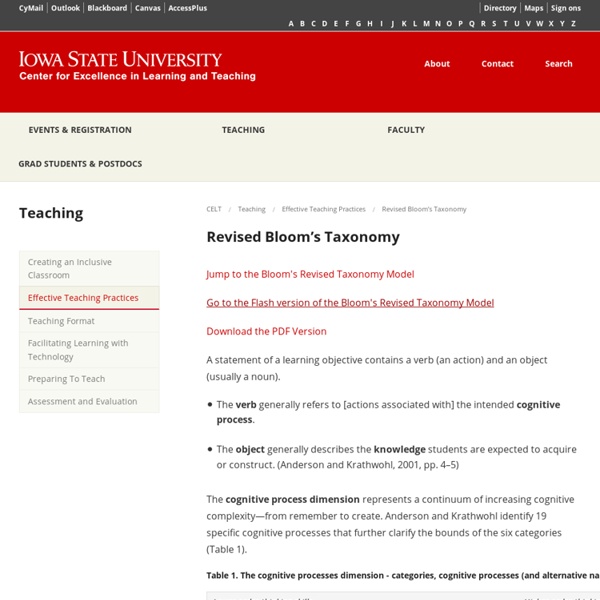The Best Resources For Helping Teachers Use Bloom’s Taxonomy In The Classroom
Bloom’s & SOLO ‘are not Just Colorful Posters we Hang on the Wall’ is my two-part series at Education Week Teacher. Bloom’s Taxonomy is talked about a lot in educational circles. However, if you believe a recent survey of visits to 23,000 U.S. classrooms, the higher-order thinking skills it’s ideally designed to promote doesn’t get much use. And I can understand why. It’s easy to get caught-up in the day-to-day work involved in teaching a class or multiple classes, and it’s easy to fall into the trap of doing the “usual stuff” and not “think out of the box.”
Blooming Orange: Bloom's Taxonomy Helpful Verbs Poster
Here’s another poster to help get you thinking about how you can apply Bloom’s higher-order thinking skills with your children. This poster shows the segments of an orange with each segment relating to a thinking skill and some helpful verbs to serve as prompts. While there are many more verbs that we could have added, we felt that including just seven in each segment would make them easier to remember (For more information, see Miller’s paper “The Magical Number Seven, Plus or Minus Two: Some Limits on Our Capacity for Processing Information.” We thought it would be interesting to depict the verbs in a circular form as opposed to a hierarchical list, given that these skills don’t often occur in isolation and are interconnected. We went through several concepts including a wheel, a pie, and an apple, but somehow the orange seemed to work best when we put everything together.
Bloom’s Taxonomy
Background Information | The Original Taxonomy | The Revised Taxonomy | Why Use Bloom’s Taxonomy? | Further Information The above graphic is released under a Creative Commons Attribution license. You’re free to share, reproduce, or otherwise use it, as long as you attribute it to the Vanderbilt University Center for Teaching. For a higher resolution version, visit our Flickr account and look for the “Download this photo” icon.
Revised Bloom’s Taxonomy [Flash Version] – CELT
If you have trouble accessing the interactive Flash-based model below, the content is available via: A statement of a learning objective contains a verb (an action) and an object (usually a noun). The verb generally refers to [actions associated with] the intended cognitive process.The object generally describes the knowledge students are expected to acquire or construct. (Anderson and Krathwohl, 2001, pp. 4–5) The cognitive process dimension represents a continuum of increasing cognitive complexity—from remember to create.
Bloom's Digital Taxonomy Verbs [Infographic]
When using Bloom’s Digital Taxonomy (a revised take on Bloom’s devised by educator Andrew Churches), it helps to have a list of verbs to know what actions define each stage of the taxonomy. This is useful for lesson planning, rubric making, and any other teacher-oriented task requiring planning and assessment strategies. The Bloom’s Digital Taxonomy verbs in this handy infographic apply specifically to each stage of the taxonomy.
249 Bloom's Taxonomy Verbs For Critical Thinking
249 Bloom’s Taxonomy Verbs For Critical Thinking by TeachThought Staff Bloom’s Taxonomy’s verbs–also know as power verbs or thinking verbs–are extraordinarily powerful instructional planning tools. In fact, next to the concept of backwards-design and power standards, they are likely the most useful tool a teacher-as-learning-designer has access to.
Bloom’s Digital Taxonomy Resources
As part of preparing for a series of presentations at various conferences this year, I have developed six quick sheets for Bloom’s Digital Taxonomy. These resources outline the different taxonomic levels and provide the Digital Taxonomy Verbs with some (this is not exhaustive) possibilities for classroom use. For the complete Bloom’s Digital Taxonomy go to the Educational Origami Wiki @ Here are the quick sheets: As always I would appreciate comments, feedback and suggestions.
UDL Guidelines 2.0
The goal of education in the 21st century is not simply the mastery of content knowledge or use of new technologies. It is the mastery of the learning process. Education should help turn novice learners into expert learners—individuals who want to learn, who know how to learn strategically, and who, in their own highly individual and flexible ways, are well prepared for a lifetime of learning. Universal Design for Learning (UDL) helps educators meet this goal by providing a framework for understanding how to create curricula that meets the needs of all learners from the start. The UDL Guidelines, an articulation of the UDL framework, can assist anyone who plans lessons/units of study or develops curricula (goals, methods, materials, and assessments) to reduce barriers, as well as optimize levels of challenge and support, to meet the needs of all learners from the start.
Five of the best CLIL resources online - CLIL Media
In the posts on this website I usually share my opinion on CLIL as well as share some ideas of others. This time however, I would like to share CLIL resources that I think are really worth your time and can be used to advance both your knowledge of CLIL as well as help you with ideas for your lessons. 1.
CLIL: A lesson framework
Underlying principlesClassroom principlesLesson frameworkConclusion Underlying principlesThe principles behind Content and Language Integrated Learning include global statements such as 'all teachers are teachers of language' (The Bullock Report - A Language for Life, 1975) to the wide-ranging advantages of cross-curricular bilingual teaching in statements from the Content and Language Integrated Project (CLIP). The benefits of CLIL may be seen in terms of cultural awareness, internationalisation, language competence, preparation for both study and working life, and increased motivation. While CLIL may be the best-fit methodology for language teaching and learning in a multilingual Europe, the literature suggests that there remains a dearth of CLIL-type materials, and a lack of teacher training programmes to prepare both language and subject teachers for CLIL teaching. The theory may be solid, but questions remain about how theory translates into classroom practice.



